All Our Designs

Plans will be sent as a zip file once payment has been received. This is no longer an automated system, so please allow 48 hours for your order to be processed and your plans emailed to you.

So I decided the Eagle 24 design would put more emphasis on interior space while still keeping a simple build. The photo above shows a slightly modified Eagle just after launching. Modified by extending the hulls to 8m (26ft) and adding a small central cuddy. See more photos below.
Accordingly it has more freeboard and a longer cabin than my earlier designs, resulting in 1.7m (5ft6in) headroom and bunks over 750mm (2ft6in) wide with sitting headroom. The high freeboard has the added advantage that the boat is much drier when underway. The extra windage from the bigger hulls never seems to cause the problems some people expect.
The flat bottomed chined hulls offer more space than any other shape, yet are easy to build in sheet plywood.This builder is building his Eagle outside

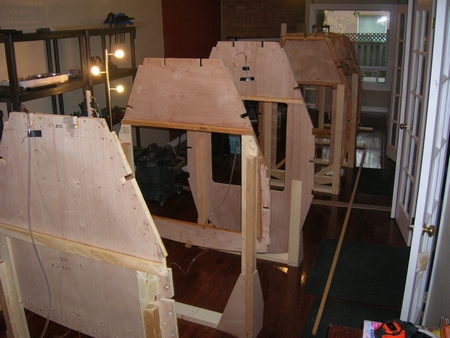

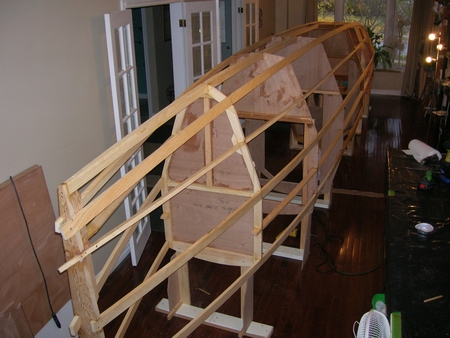

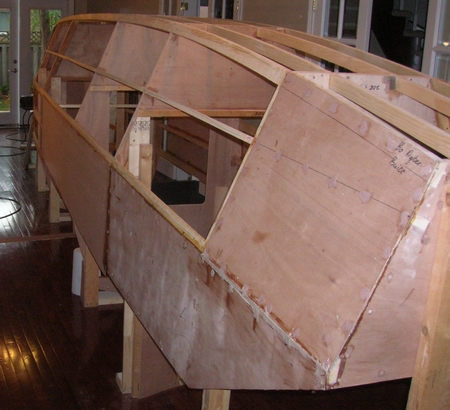


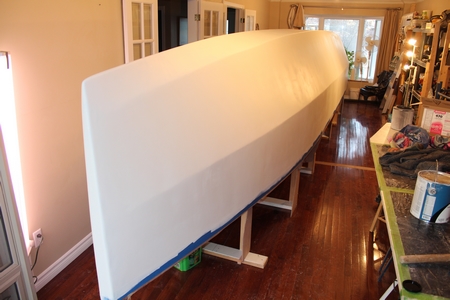

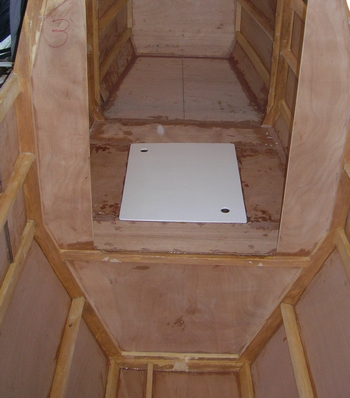




The rig and deck layout have been drawn based on the experience gained from over 50 years of small boat sailing and personally owning eight trailable catamarans in which I have sailed thousands of miles
The deep mastbeam coupled with a solid cockpit floor instead of a trampoline offers security and a dry ride for families. Side opening hatches into the hulls mean the crew can safely get below without going near the gunwales. So a small child can be fitted with a harness and be able to roam freely round the 100sqft cockpit and get into the hulls, yet never reach the side of the boat.
The simple, no rotating fractional rig is efficient and easy to raise, even singlehanded. See HERE for the basic method. An optional racing rig is available for experienced sailors who want more speed or who sail in a lightwind area.
The hulls are Veed forwards to prevent slamming into a seaway, but are otherwise flat bottomed. This means they stay upright by themselves, which makes building a LOT easier as you don't need to fit and move chocks and of course no chocks are needed for the telescopic trailer. Such a trailer means that it is possible to assemble and rig the boat singlehanded.
Stock 150mm (6in) aluminium cross beams are used to save weight and build time. However there is a wood beam option for those who don't have easy access to tubes. The main crossbeams are attached to hulls with metal straps, the most reliable way of attaching beams - no squeaking, no chafe and no flexing. The mastbeam sits on simple brackets and does not intrude into the hull.
The Eagle is seaworthy enough for coastal passage making and offshore trips in good weather, so there would be no problem sailing one across the English Channel or from Florida to the Bahamas. However, remember that, in common with all small boats, it is the crew that will fail before the boat. So I don't suggest sailing more than 70 miles or so non stop, nor cruising overnight with more than 2 adults and 2 children on board. But please see an owners report!
Having said that I've lost count of the number of times I've sailed from Plymouth to the Solent non stop in our various Striders, Wizard and Gwahir. That's 130 miles, and it's usually to windward on the return trip.
So, to sum up. The Eagle is a safe, comfortable boat that will be fast, fun and yet predictable to sail. Easily built with lots of room

You can download a PDF study plan HERE (revised Nov 2015)
Please email me at This email address is being protected from spambots. You need JavaScript enabled to view it. to obtain a comprehensive study pack of photos and sample plan sheets
Dozens of Eagles are now being built
Basic Materials List
37 sheets 6mm plywood
5 sheets 9mm plywood
2in x 1in 200m
11/2in x 1in 120m
1in x 1in 50m
45kgs min epoxy
1kg wood flour or similar filler
20kgs min 200g glass cloth (biaxial +/-45deg recommended for joints)
2000 stainless steel countersunk screws 3/4in x 6
filler/paint as required
All plywood to be best quality Marine grade Gaboon/okoume pl y.
Sheet sizes are 8' x 4', 2440x1220
All timber to be at least "Joinery Quality".
Unless noted otherwise all timber is softwood, eg Douglas Fir, Sitka Spruce, Yellow Cedar or similar.
A ll timber is "PAR", or "Planed all Round". Thus sizes given are nominal, ie 2" x 1" has a finished planed size of approx 45mm x 20mm. (Note: It is usually cheaper t o buy wider planks, eg buy 2" x 1" and cut it in half to create 1" x 1").
Epoxy glue is recommended for all glue joints as it is gap filling and the strongest and most watertight glue
List excludes errors and waste









